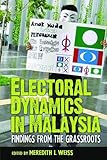Electoral Dynamics in Malaysia : Findings from the Grassroots / ed. by Meredith Weiss.
Material type: TextPublisher: Singapore : ISEAS Publishing, [2013]Copyright date: ©2013Description: 1 online resource (272 p.)Content type:
TextPublisher: Singapore : ISEAS Publishing, [2013]Copyright date: ©2013Description: 1 online resource (272 p.)Content type: - 9789814519113
- 9789814519120
- East Indian diaspora -- Social conditions
- East Indians -- Malaysia -- Economic conditions
- East Indians -- Malaysia -- Race relations
- Elections -- Malaysia
- Elections--Malaysia
- Malaysia. Parlimen. Dewan Rakyat--Elections, 2013
- Marginality, Social -- Malaysia
- POLITICAL SCIENCE / American Government / General
- 305.5 23
- JQ1062.A95 E45 2014
- DS595.2.E2 B45 2015
- online - DeGruyter
| Item type | Current library | Call number | URL | Status | Notes | Barcode | |
|---|---|---|---|---|---|---|---|
 eBook
eBook
|
Biblioteca "Angelicum" Pont. Univ. S.Tommaso d'Aquino Nuvola online | online - DeGruyter (Browse shelf(Opens below)) | Online access | Not for loan (Accesso limitato) | Accesso per gli utenti autorizzati / Access for authorized users | (dgr)9789814519120 |
Frontmatter -- Contents -- List of Tables -- Foreword -- Acknowledgements -- Glossary & Acronyms -- Chapter 1. Introduction: Patterns and Puzzles in Malaysian Electoral Dynamics -- Chapter 2. Arau, Perlis: The Irresistible Charm of Warlords, Women and Rewards? -- Chapter 3. Padang Serai, Kedah: Between the ‘Personal Touch’ and the Generous Hand -- Chapter 4. Kuala Nerus, Terengganu: New Malay Politics? -- Chapter 5. Balik Pulau, Penang: Home Run for the Home Boys -- Chapter 6. Lumut, Perak: Patronage, Clientelism and the Post-Coup Order -- Chapter 7. Kuantan, Pahang: Revealing the Ordinary -- Chapter 8. Pandan, Selangor: New Electoral Dynamics in Urban Malaysia -- Chapter 9. Kepong and Titiwangsa, Kuala Lumpur: Messages or Money? -- Chapter 10. Rembau, Negeri Sembilan: Personalities and Promises -- Chapter 11. Pulai, Johor: A Tale of Two Coalitions -- Chapter 12. Gelang Patah, Johor: Did Lim Kit Siang Truly Win His Last Gamble? -- Chapter 13. Kota Marudu and Keningau, Sabah: Personality, Patronage and Parochial Politics -- Chapter 14. Tuaran, Sabah: Party Loyalty and Rational Voting -- Chapter 15. Kota Kinabalu, Sabah: BN Loses Its ‘Fixed Deposit’ -- Chapter 16. Beaufort, Sabah: Whither Lajim’s Popularity? -- Chapter 17. Sibu and Lanang, Sarawak: Defeat of the Bosses -- Contributors
restricted access online access with authorization star
http://purl.org/coar/access_right/c_16ec
Malaysia’s 13th general election, held 5 May 2013, saw an unprecedentedly close race between the incumbent Barisan Nasional (National Front, BN) and Pakatan Rakyat (People’s Alliance, Pakatan) coalitions. For the first time in Malaysian history, a challenger coalition not only kept the BN from regaining the two-thirds parliamentary super-majority it had lost in the previous election, in 2008, but eked out a slim majority of the popular vote. While many Malaysian election is a big event, this one in particular merits close scrutiny. The present volume offers evidence and analysis with which to probe both the merits of common interpretations of who voted how, and why, and to suggest new readings on Malaysian politics. “This team of well-coordinated young scholars has produced what is, without any argument, the best, most comprehensive and broadly based study ever of Malaysian electoral politics. With a common approach and format, their local case studies highlight not the ‘wholesale’ politics of broad national party strategy but the ground-level ‘retail’ promotion of local candidates. Malaysian electoral politics is local, these closely-focused studies show. because voters wish to ‘own’ their local representatives, and they can own only those whom they know and can in some measure control. This is how fresh, young eyes see the familiar ‘slog’ of this country's ground-level electioneering. Thanks to them we now have a new base-line for future Malaysian electoral studies.” -- Clive Kessler, The University of New South Wales
Mode of access: Internet via World Wide Web.
In English.
Description based on online resource; title from PDF title page (publisher's Web site, viewed 01. Dez 2022)


